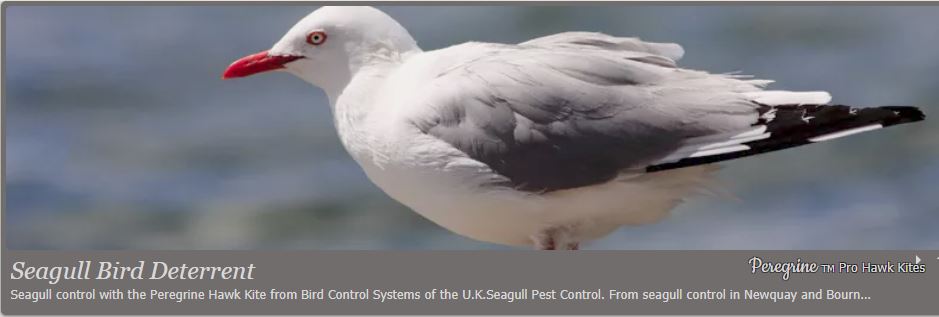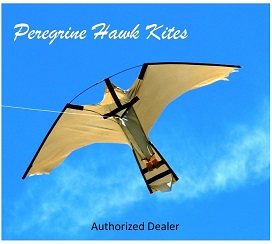 Seagull Bird Control
Seagull Bird Control
Seagulls are instinctively afraid of the Peregrine Hawk Kite.
In Canada, it is against the Federal Migratory Birds Convention Act to harm a seagull or destoy a nest with a penalty ranging from $5,000-300,000.
The Hawk Kite is very effective for Seagull Control. We have sold hundreds of Hawk Kite kits to customers in Victoria, Vancouver, around the Great Lakes and in all Atlantic provinces.
Seagulls are generally medium to large birds, usually grey and white, often with black markings on the head and wings. Seagulls have harsh squawking calls, longer bills and webbed feet.
Seagulls are resourceful, inquisitive and very intelligent. They have complex methods of communication and a developed social structure. They breed on every continent, and are even found in the high Arctic.
Seagulls are highly adaptable feeders that opportunistically take a wide range of food sources. Seagulls will eat anything from saltwater invertebrates to fruit and landfill garbage.
Seagulls are moving into built up areas to nest. One of the main reasons is because food sources are readily available both from people deliberately feeding them and an ongoing issue of refuse strewn around roads and streets. Breeding seagull pairs court in March and commence nest building from early April onwards (times may vary by province). Nests are generally constructed from straw, grass, twigs, paper and any other material the gull can conveniently use. These nests can be large and if they are made of material accumulated over several years and they can become quite heavy. This means that if a breeding site is established the gulls will most likely return year after year.
May onwards eggs are laid from early with 2 or 3 being the usual number. The eggs take about three weeks to hatch, which means that the first chicks are seen around the beginning of June. The chicks grow quickly and are quite active, which means that they often fall from their nests. In towns this often means that they are unable to return to their nests. Small chicks will die if they are not returned, but the larger chicks will be protected by their parents and fed on the ground. The chicks generally fledge in August and then take about three years to reach maturity when they in turn will start to breed. The life expectancy for gulls can be up to 20 years.
Gulls are social creatures and once roof nesting gets a hold, other gulls will start to move in to an area and nest on adjacent buildings, until their numbers build up sufficiently that a colony is established.
The best method to prevent gulls from nesting on your property is to sufficiently proof your property against the birds so that the nests are not built there in the future. The more people who proof their properties, and maintain them, the more likely it is that gulls will be forced out of residential areas to nest in other areas where they will be less likely to be a nuisance to the
public.
Seagull cause nuisance issues for most people including:
-
Noise caused by calling seagulls.
-
Their heavy footsteps on rooftops from seagulls.
-
Birds dive bombing and swooping on animals and people.
-
Seagull mess caused by their droppings fouling washing, cars, gardens, people
and walkways.
-
The risk to Public Health due to the diseases that Seagulls carry.
-
Damage to properties caused by gulls picking at roofing materials and by
nests which block gutters or hold moisture against the building structure.
-
Gas flues can become blocked by nesting materials which can have
serious consequences.
-
Mites and other insects can get a hold in houses from the old, abandoned
nests once the seagull chicks have fledged.
Fortunately, Seagulls are scared of the PeregrineTM Hawk Kite as they have a distinctive fear of the Peregrine Falcon.
The Peregrine TM Hawk Kite is a self-launching pigeon and seagull-scaring kite. The combination kits consists of a either a telescopic flexible 5 or 7 metre fibreglass pole with a specially designed kite attached to the pole on a high strength line or a 6.25 metre aluminium pole and line. It is fixed easily by inserting our tough glass fibre stake into the ground or strapping to a building, then positioning the pole over the top for the hawk kite combination or attaching the kite and line to the 6.25 metre aluminium pole. – it takes about five minutes to complete installation.
The PeregrineTM Hawk Kite scares seagulls and pigeons off the buildings with little maintenance day and night. They are developed to be silent so they do not both yourself or neighbors! The Peregrine Hawk Kites are made heavy-duty material with strong stitching so they are long lasting. They are hand made in England.
The PeregrineTM Hawk Kite bird controller is made with the highest quality materials to make it as durable as possible. Unlike many other pigeon scaring devices Hawk Kite is always changing its pattern of flight. It varies its manifestation by altering its flight pattern, speed and height depending on the strength of the wind therefore the pigeons, seagulls and other birds never become accustomed to the kite patterns.
If you’ve got pigeons or seagulls you’ve most likely have ongoing issues with them. These issues will get worse each year as the pigeons and seagulls nest year over year. The Peregrine Hawk Kite is a wise choice for a quick, cost effective relief of the problematic birds. The bird scaring Hawk Kite is always flying, it is quick and easy to move and very effective. Takes minutes to put up and seconds to take down. Can be placed close to the edges of areas where pigeon tend to attack without upsetting any neighbors, as they are silent. When in need of storing the Hawk Kite the pole simple folds down and is stored in it’s original box until needed once again.
